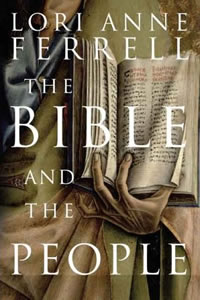Book Notes
 Lori Anne Ferrell, The Bible and the People (New Haven: Yale University Press, 2008), 273pp.
Lori Anne Ferrell, The Bible and the People (New Haven: Yale University Press, 2008), 273pp.
In 2004 Lori Anne Ferrell was the guest curator for a Huntington Library exhibit called "The Bible and the People." This book is a spin-off of her research, which was also the subject of a 2007 PBS documentary. Ferrell has written what she calls a "cultural biography" of the "restless, peripatetic text that is the Christian Bible." She treats the Bible as a material artifact, and limits herself primarily to English Bibles of the last thousand years. Her book includes 55 black and white illustrations of various Bibles that she examines.
Ferrell begins with the two-volume Gundulf Bible, an illuminated manuscript from the 11th century, and eight chapters later concludes with teen-magazine format Bibles of the 20th-century like Revolve and Refuel. In between she moves the reader from single, hand-copied Bibles to mass produced "Paris Bibles" (1200–1500) that were both standardized and portable, and to lay Bibles, "Psalters," and Victorian family Bibles intended for private devotion. Chapter divisions and verse numbers entered in the sixteenth century, as did the intense and divisive "politics of translation" with the rise of the Protestant movement. When she moves to America, we learn that our first Bibles were in Spanish, German, and Algonquian (p. 119). In her earlier chapters Ferrell argues that widespread illiteracy did not necessarily mean Biblical ignorance, while in later chapters she observes that Bibles newly translated into the vernacular of common people did not guarantee understanding.
The many iterations of this singular book are fascinating. Far from being modern conventions, many centuries ago all sorts of study aids were included in Bibles — pronunciation guides, foldout maps, footnotes, charts, graphs, glosses, illustrations, marginalia, and annotations. The Kitto Bible of 1836, for example, comes in 66 volumes and includes over 30,000 prints and illustrations. Economic market forces of production and distribution, cultural changes, political upheaval, advances in textual criticism, artistic devotion, religious partisanships of all sorts, liturgical innovations, all of these and more, Ferrell shows, are part of the Bible's very human biography.


